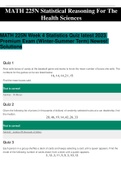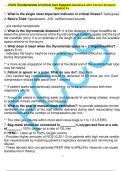-
1. Exam (elaborations) - Nr 601 week 5 assignment, nr 601: care of the maturing and aged family, chamberlain
-
2. Exam (elaborations) - Nr 601 week 5 case study paper final, nr 601: care of the maturing and aged family, c...
-
3. Exam (elaborations) - Nr 601 week 5 case study mrs. r, nr 601: care of the maturing and aged family, chambe...
-
4. Exam (elaborations) - Nr 601 week 5 case study diabetes, nr 601: care of the maturing and aged family, cham...
-
5. Exam (elaborations) - Nr 601 week 5 a case study of mrs.g, nr 601: care of the maturing and aged family, ch...
-
6. Exam (elaborations) - Nr 601 week 5 primary care of the maturing and aged family case study, nr 601: care o...
-
7. Exam (elaborations) - Nr 601 week 5 case study assignment, nr 601: care of the maturing and aged family, ch...
-
8. Exam (elaborations) - Nr 601 week 5 case study assignment, nr 601: care of the maturing and aged family, ch...
-
9. Exam (elaborations) - Nr 601 week 2 copd case study part 2, nr 601: care of the maturing and aged family, c...
-
10. Exam (elaborations) - Nr 601 week 2 copd case study part 1 (initial post, faculty and peer responses), nr 6...
-
11. Exam (elaborations) - Nr 601 week 7 quiz dementia-knowledge check, nr 601: care of the maturing and aged fa...
-
12. Exam (elaborations) - Nr 601 quiz 7-knowlwdge check, nr 601: care of the maturing and aged family, chamberl...
-
13. Exam (elaborations) - Nr 601 quiz 5- knowledge check, nr 601: care of the maturing and aged family, chamber...
-
14. Exam (elaborations) - Nr 601 week 5 quiz-knowledge check, nr 601: care of the maturing and aged family, cha...
-
15. Exam (elaborations) - Nr 601 week 3 quiz- knowledge check, nr 601: care of the maturing and aged family, ch...
-
16. Exam (elaborations) - Nr 601 week 3 quiz- knowledge check, nr 601: care of the maturing and aged family, ch...
-
17. Exam (elaborations) - Nr 601 final study guide questions, nr 601: care of the maturing and aged family, cha...
-
18. Exam (elaborations) - Week 8-final exam outline -nr 601 final exam review, nr 601: care of the maturing and...
-
19. Exam (elaborations) - Nr 601 final exam study guide (version 2)-nr 601 comprehensive final exam study guide...
-
20. Exam (elaborations) - Nr 601 final exam study guide (version 1)-nr 601 comprehensive final exam study guide...
-
21. Exam (elaborations) - Nr 601 final exam-( version 2)-100qa, nr 601: care of the maturing and aged family, c...
-
22. Exam (elaborations) - Nr 601 final exam-( version 1)-100qa, nr 601: care of the maturing and aged family, c...
-
23. Exam (elaborations) - Nr-601 final exam-(2 versions)-200qa, nr 601: care of the maturing and aged family, c...
-
24. Exam (elaborations) - Nr 601 week 6 quiz review, nr 601: care of the maturing and aged family, chamberlain
-
25. Exam (elaborations) - Nr 601 midterm study questions, nr 601: care of the maturing and aged family, chamber...
-
26. Exam (elaborations) - Nr 601 midterm exam review, nr 601: care of the maturing and aged family, chamberlain
-
27. Exam (elaborations) - Nr 601 midterm exam study guide (version 3), nr 601: care of the maturing and aged fa...
-
28. Exam (elaborations) - Nr 601 midterm exam study guide (version 2), nr 601 question bank nr601 test bank (ch...
-
29. Exam (elaborations) - Nr 601 kennedy malone apn older adults sample questions-ch-1 to ch-19, nr 601: care o...
-
30. Exam (elaborations) - Nr 601 midterm exam study guide (version 1), nr 601: care of the maturing and aged fa...
-
31. Exam (elaborations) - Nr 601 midterm exam, nr 601: care of the maturing and aged family, chamberlain
-
32. Exam (elaborations) - Nr 601 week 4 midterm exam (practice questions and answers), nr 601: care of the matu...
-
33. Exam (elaborations) - Nr 601 week 2 quiz answers, nr 601: care of the maturing and aged family, chamberlain
-
34. Exam (elaborations) - Nr 601 week 4 midterm exam (practice questions and answers), nr 601: care of the matu...
-
35. Exam (elaborations) - Nr 601 quiz 5 mature and aging adult-week 6 de qs 106 endocrine and metabolic problem...
-
36. Exam (elaborations) - Nr 601 midterm exam study guide week 1-4, nr 601: care of the maturing and aged famil...
-
Show more






